Inside: Dewdrop stitch instructions, charts and video tutorial for the classic needle knit stitch pattern plus a unique variation.
It’s early and the coffee isn’t even done yet. But Bella is whining to go outside. I know I’m going to have to be the one who takes her out because the kids are getting ready for school. This is not one of the joys of being a dog mom. I step outside into the relative coolness of morning and Bella bolts off to her corner of the yard. My eyes follow the trail of her dark pawprints as she scatters the shimmering drops off the blades of grass. Then it hits me how truly beautiful the sparkling dew drops are. I smile and know it’s going to be a good day.
I know I’m not the only one that has a moment like that. The dew drop stitch pattern has been around for needle knitters for a long time. Somewhere back in history an inspired knitter mimicked those little droplets that fade away in the heat of the day.
This beautiful stitch pattern displays offset clusters and small eyelets to create a diamond-like look. The dewdrop stitch uses a multiple of 6 +7 stitches over 8 rows. It can be worked either as a flat panel or in the round. To work it in the round omit the edge stitches (marked in green on the charts)
Need help with stitch multiples? See the charts below for more explanation.
I first shared the loom knit variation of this stitch pattern several years ago when I saw Charmian Round’s stunning project. I intended to make a video, but life happened and it got put on the back burner.
Finally, the wait for a video tutorial is over!
A funny thing happened on the way to the tutorial…
As I studied the stitch pattern in detail I realized that Charmian used a variation on the original stitch pattern. There is one stitch in the dew drop cluster that is different, but it changes the overall look of the pattern a tiny bit.
TLDR: In case you don’t speak knitting the classic stitch and variation are only different in ONE stitch.
If knitspeak doesn’t send you screaming from the room I’ve explained how the two stitch patterns are different below.
The Classic Dewdrop uses a sssk (slip, slip, slip, knit). You may also see this written as sl1, ssk. The Dewdrop Variation substitutes incorporates a sl1, k2tog instead of the sssk. Since an ssk is a left-leaning decrease and a k2tog is a right-leaning decrease the overall look of the cluster is just a little bit different. The classic has one stitch that leans right while in the variation it leans left.
I made a video showing both the classic dewdrop stitch and the variation so YOU can choose which one you like better. Keep scrolling for detailed instructions, charts and the video.
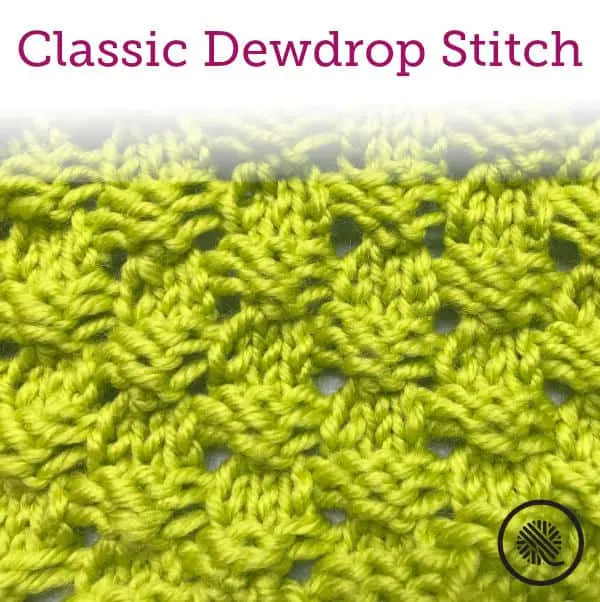
Materials:
Materials list may contain affiliate links that cost you nothing but helps support GKK.
Loom: Any gauge loom
Knitting Board Premium Round Knitting Loom (3/8″ gauge) used for sample.
Yarn: Yarn weight appropriate for loom
Red Heart Chic Sheep (#4 worsted weight yarn) in color green used for sample.
Notions: Loom knitting tool, Crochet hook, Yarn needle
Abbreviations:
k = u-knit stitch
p = purl stitch
sl = slip stitch
yo = yarn over
sssk = slip, slip, slip knit
psso = pass slipped stitch over
Notes:
Slipped stitch edge: In the video I work Rows 1-7 and slip the first stitch of the row. The chart I included shows the first stitch as knit/purl, but if you prefer to slip those you may.
Instructions
Chain cast on 25 stitches.
Rows 1-3: p2, *k3, p3. Repeat from * to last 5 sts. k3, p2.
Row 4: ssk, *yo, sssk, yo, k3. Repeat from * to last 2 sts. k2tog
Rows 5-7: k2, *p3, k3. Repeat from * to last 5 sts. p3, k3.
Row 8: ssk, yo, k3, *yo, sssk, yo, k3. Repeat from * to last 2 sts. k2tog.
Repeat Rows 1-8 until you reach the length you require.
Bind off with flat panel bind off.
Classic Chart
The red boxes contain one full pattern repeat of the dewdrop stitch. (To work the dewdrop in the round only use the 6-stitch repeat show in red.)
When working the dewdrop as a flat panel you need to add 2 stitches at the beginning of the row and 5 at the end to balance the pattern. These are shown in the green boxes at the edges of the chart.
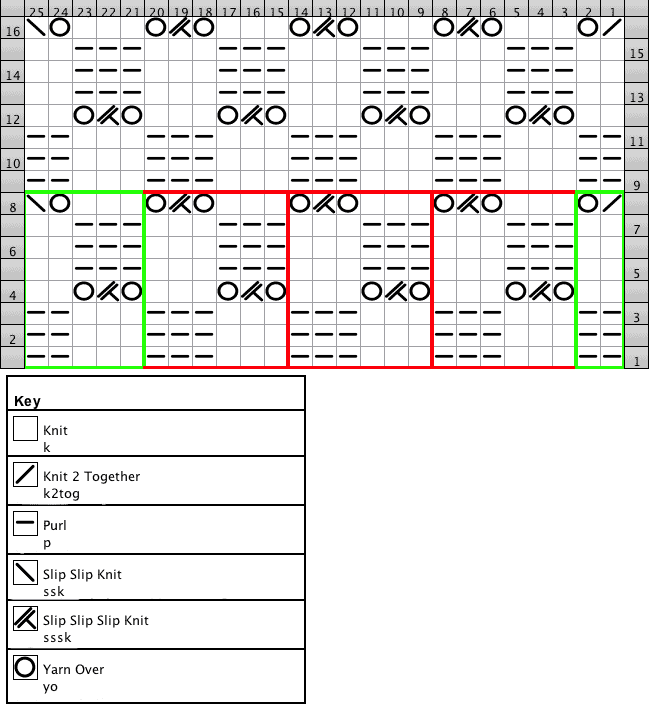
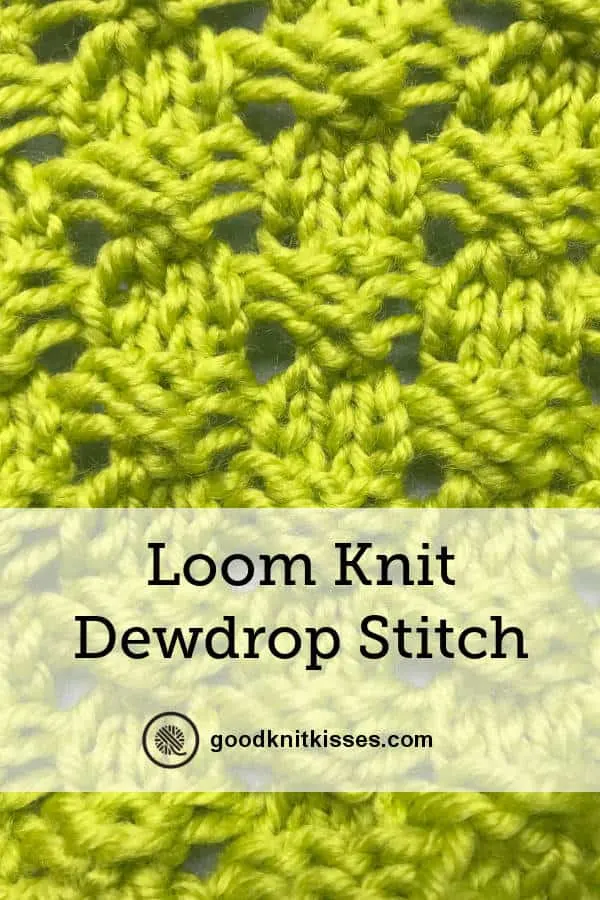
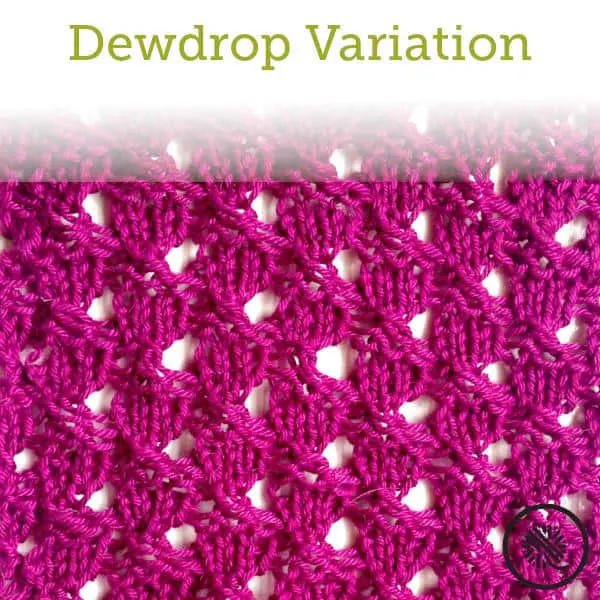
by Charmian Round
Megan Goodacre’s knitted washcloth pattern inspired me to try this stitch. :
The dewdrop is a traditional English stitch pattern. I found it in Barbara Walker’s First Treasury of Knitting Patterns and James Norbury’s Traditional Knitting Patterns: from Scandinavia, The British Isles, France, Italy, and Other European Countries.
Materials:
Loom: 3/8″ gauge loom
Knit UK Red 26 peg loom with extra pegs used for sample.
Yarn: Worsted weight yarn
100% cotton yarn used in sample.
Notions: Loom knitting tool, Crochet hook, Yarn needle
Abbreviations:
k = u-knit stitch
p = purl stitch
sl = slip stitch
yo = yarn over
sk2p = slip 1, knit 2 stitches together, pass the slipped stitch over
k2tog = knit 2 stitches together
psso = pass slipped stitch over
Notes:
Slip stitch edge: The traditional dewdrop pattern does not have a slipped stitch edge. The written pattern lists the slipped stitches at the beginning of Rows 1-7, but the chart shows the knit/purl stitches at the beginning of these rows. You can use either method.
Flat Panel Bind Off: Click this LINK for the method she used.
Stitch Pattern: The stitch uses a “yo,sk2p, yo” (also referred to as “yo, sl1-k2tog-psso, yo”) in Rows 4 and 8 to create the clusters. It sounds confusing but is easy to work once you understand. It is worked over 3 pegs. See Figures A-I below for a step by step photo tutorial.
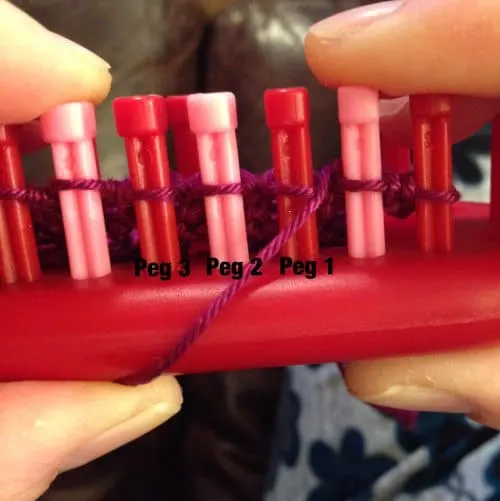
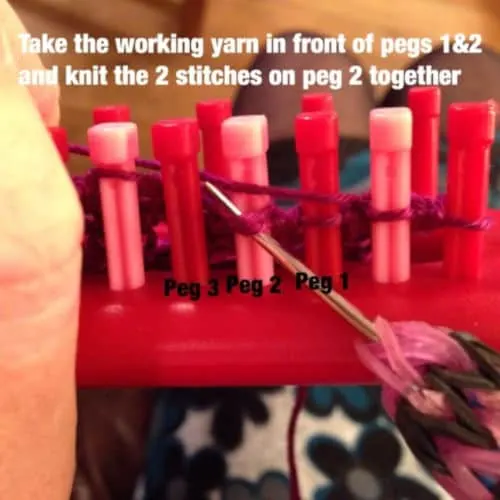
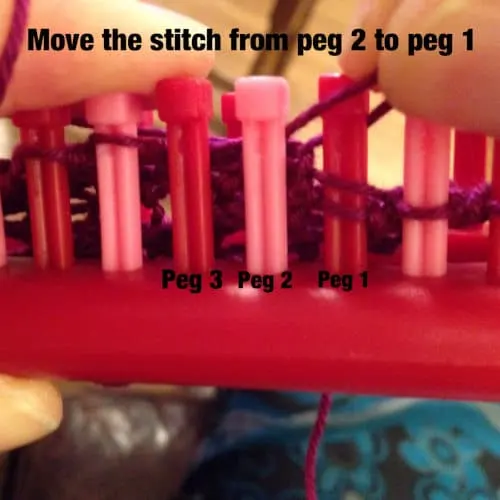
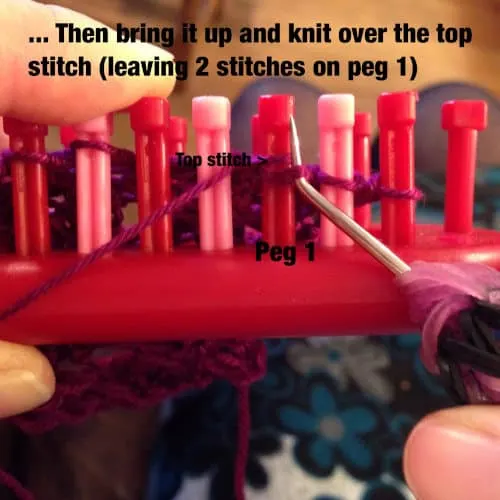
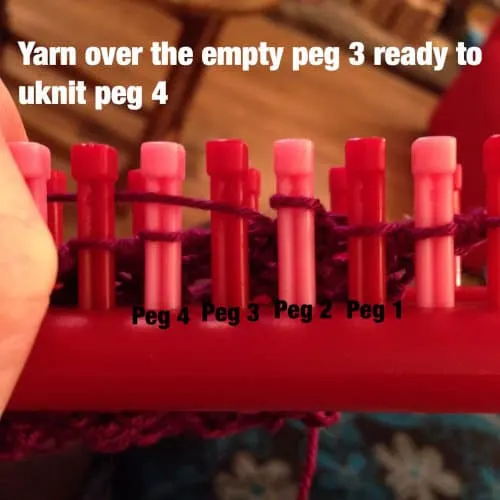
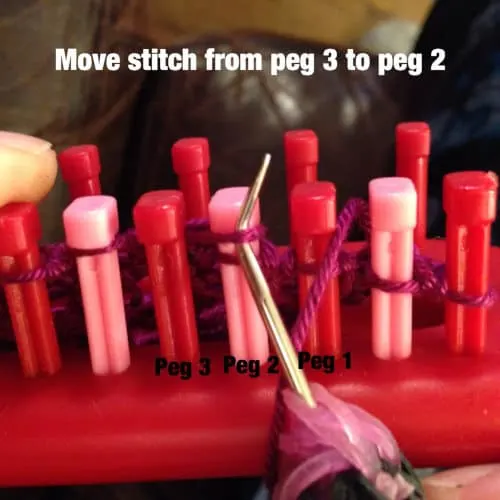
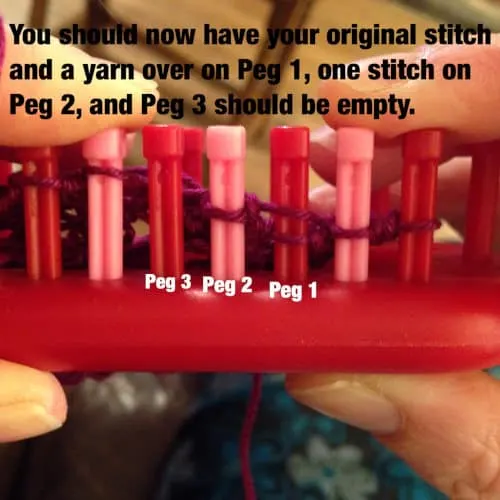
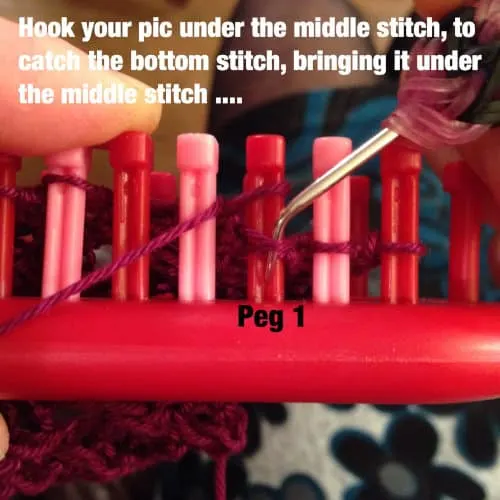
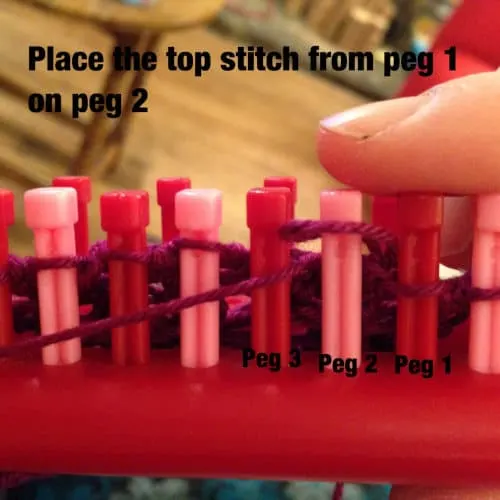

Instructions
Crochet cast on 25 stitches.
Rows 1-3: sl1, p1, *k3, p3. Repeat from *. End last repeat with p2 instead of p3.
Row 4: sl1, k1, *yo, sk2p, yo, k3. Repeat from *. End last repeat with k2 instead of k3.
Rows 5-7: sl1, k1, *p3, k3. Repeat from *. End last repeat with k2 instead of k3.
Row 8: k2 tog, yo, k3, *yo, sk2p, yo, k3. Repeat from *. End last repeat with k2 (after the final k3).
Repeat Rows 1-8 until you reach the length you require.
Bind off with flat panel bind off.
Variation Chart
The red boxes contain one full pattern repeat of the dewdrop stitch. (This is the multiple of 6 you need to work in the round.)
When working the dewdrop as a flat panel you need to add 2 stitches at the beginning of the row and 5 at the end to balance the pattern. These are shown in the green boxes at the edges of the chart.
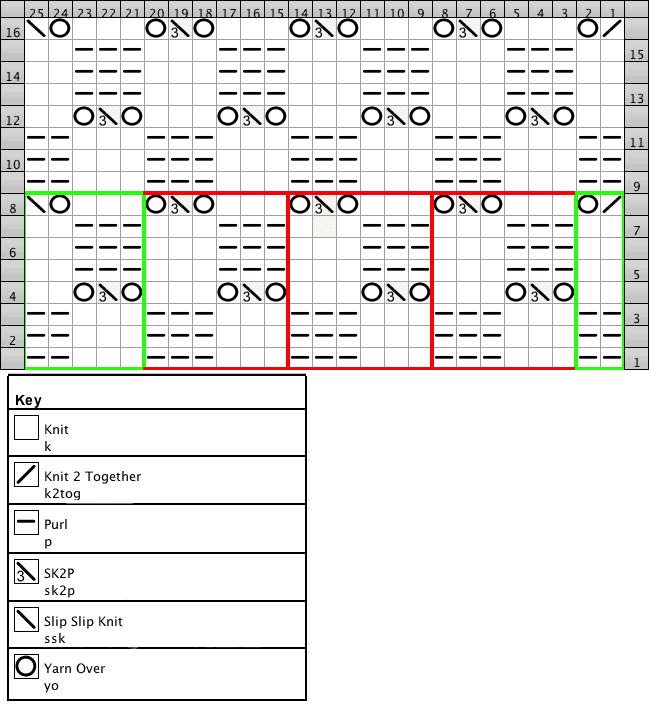
About Charmian Round
Charmian was inspired to start loom knitting in August 2014 when she came across some loom knitting websites while searching for loom band patterns for her two sons. Since then, she has discovered that loom knitting is the perfect antidote to her working life stress as a Clinical Psychologist, and has to stop herself repetitively recommending it to everyone she meets.
You can see Charmian’s loom projects and more on her Chalkycat Facebook page.
Are you ready to loom knit the dewdrop stitch and create a project that brings you back to the refreshing calm of the early morning dew? Watch the video below to see BOTH versions of this stitch.
Dewdrop Stitch Tutorial Video: Classic & Variation (Coming Aug. 23, 2019)
For more loom knit stitch patterns see these posts:
How to Loom Knit the Feather Lace Stitch
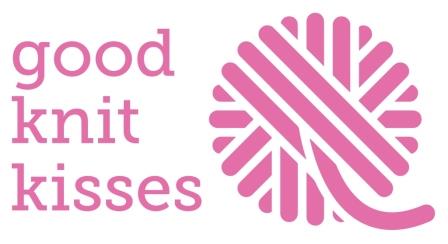
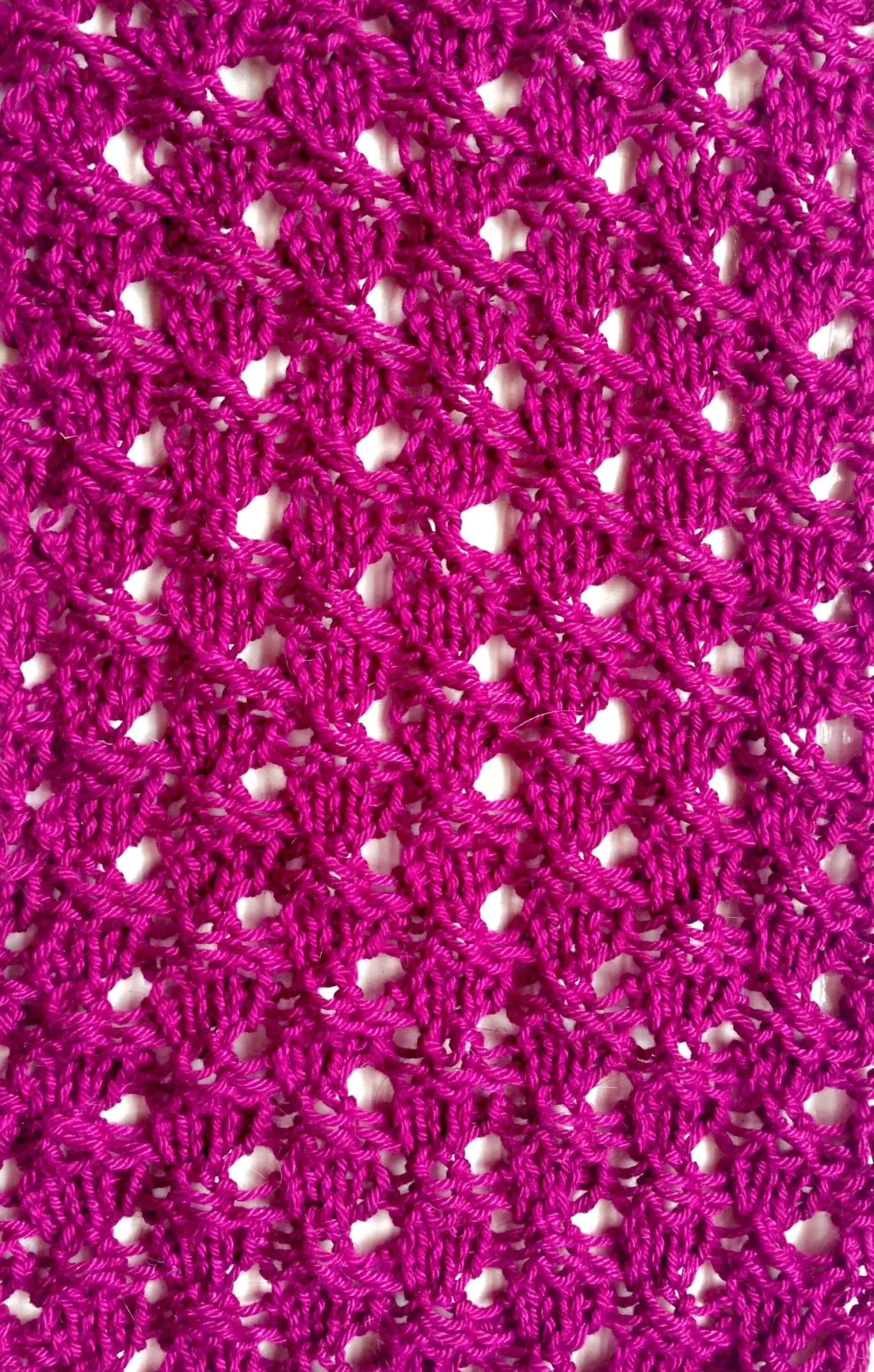
Marilyn Jean Gray
Tuesday 19th of May 2020
My favorite so far at this new loom knitting adventure I'm on. I appreciated the chart and detailed instructions. The loom knitting Terms with definitions help so much. You are an amazing Teacher. Cheers!
Elaine donaldson
Monday 12th of November 2018
I can learn better through a video. Any chance you could do one?
Elaine donaldson
Monday 12th of November 2018
I can learn better through a video. Any chance you could do one?
Janis
Monday 30th of October 2017
Thanks for all the help you give us just starting I would be so lost without tutorials I am a visual learner can't figure out anything by written pattern
Janis
Monday 30th of October 2017
Thanks for all the help you give us just starting I would be so lost without tutorials I am a visual learner can't figure out anything by written pattern